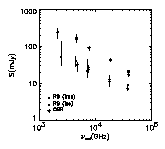
ISO observations of a sample of CSS/GPS radio galaxies
C. Fanti1,2, F. Pozzi3,2, R. Fanti1,2, S.A. Baum4, C.P. O'Dea4. M. Bremer5, D. Dallacasa3,2, H. Falcke6, T. de Graauw7, A. Marecki8, G. Miley9, H. Rottgering9, R.T. Schilizzi10, I. Snellen11, R.E Spencer12, C. Stanghellini13
1Dipartimento di Fisica, Universita di Bologna Via Irnerio 46, I-40126 Bologna,Italy2Istituto di Radioastronomia del CNR, Via Gobetti 101, I-40129 Bologna, Italy
3Dipartimento di Astronomia, Universita di Bologna, via Ranzani 1 I-40127 Bologna, Italy
4STScI, 3700 San Martin Dr., Baltimore, MD 21218, USA
5Department of Physics, Bristol University, H H Wills Physics Laboratory, Tyndall Avenue, BRISTOL, BS8 1TL, U.K.
6 Max-Planck-Institut für Radioastronomie, Auf dem Hügel 69, 53121 Bonn, Germany (hfalcke@mpifr-bonn.mpg.de)
7Laboratorium voor Ruimteonderzoek, SRON, Postbus 800, 9700 AV Groningen,The Netherlands
8Torun Centre for Astronomy, N. Copernicus University, ul. Gagarina 11, PL-87-100 Torun, Poland
9Sterrewacht, Oort Gebouw, P.O. Box 9513, 2300 RA Leiden, The Netherlands
10Joint Institute for VLBI in Europe, Postbus 2, 7990 AA, Dwingeloo The Netherlands
11Institute of Astronomy, Madingley Road, Cambridge CB3 0HA, UK
12Nuffield Radio Astronomy Laboratories, Manchester University, Jodrell Bank, Macclesfield, Cheshire SK 11 9L, UK
13Istituto di Radioastronomia del CNR, C.P. 141, I-96017 Noto (SR), Italy
Astronomy & Astrophysics, in press
Abstract:
We present results from observations obtained with ISOPHOT, on board the ISO satellite, of a representative sample of seventeen CSS/GPS radio galaxies and of a control sample of sixteen extended radio galaxies spanning similar ranges in redshift (0.2 <= z <= 0.8) and radio luminosity (P2.7 GHz >= 1026 W/Hz). The observations have been performed at lambda = 60, 90, 174 and 200 micron. The original purpose of these observations was to check whether CSS/GPS sources are associated with very gas rich galaxies, as required by the scenario in which the growth of the radio source is inhibited by the dense medium of the host galaxy. Unfortunately the resulting performance of ISOPHOT was worse than expected. As a consequence, the detection limit at 60 micron is similar to that obtained previously with IRAS but better than that at 90 micron. Seven of the CSS/GPS sources have detections >= 3 sigma at one or more wavelengths, one of which is detected at >= 5 sigma. For the comparison sample five objects have detections >= 3 sigma one of which is at >= 5 sigma. By co-adding the data we have obtained average flux densities at the four wavelengths. We found no evidence that the FIR luminosities of the CSS/GPS sources are significantly different from those of the extended objects. In our opinion this argues against CSS/GPS sources being objects ``frustrated" by an abnormally dense ambient medium. The two samples were then combined, providing FIR information on a new sample of radio galaxies at intermediate redshifts. We compare this information with what previously known from IRAS and discuss the average properties of radio galaxies in the redshift range 0.2 - 0.8. The FIR emission cannot be accounted for by extrapolation of the synchrotron radio spectrum and we attribute it to thermal dust emission. The average FIR luminosity is >= 6 * 1011 Lo. Over the observed frequency range the infrared spectrum can be described by a power law with spectral index alpha ~ 1.0 +/- 0.2. Assuming the emission to be due to dust, a range of temperatures is required, from >= 80 K to <= 25 K. The required dust masses range from 5 * 10^5 Mo for the hotter component up to 2 * 10^8 Mo for the colder one. We present also observations on four nearby (z <= 0.1) GPSs, two of which are detected at all four wavelengths.
Paper: Available in full length as PostScript and LaTex (AAS LaTex) Format.
Other publications can be found here.
Questions: Heino Falcke, hfalcke@mpifr-bonn.mpg.de